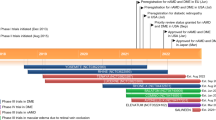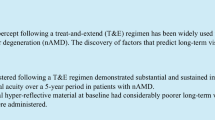Abstract
Purpose
To evaluate macular thickness fluctuations and their association with visual acuity outcome in eyes with macular edema (ME) secondary to central (CRVO) or hemiretinal vein occlusion (HRVO) treated initially with intravitreal aflibercept or bevacizumab.
Methods
Post hoc analysis of 362 patients with ME secondary to CRVO or HRVO initially randomized to six monthly intravitreal injections of aflibercept or bevacizumab. Three spectral domain optical coherence tomography (SD-OCT) central subfield thickness (CST) fluctuation measures were investigated over Months 1–12: standard deviation (SD), number of turning points (T) for each participant, and a measure denoted as Zigzag reflecting the magnitude of alternating ups and downs in a participant’s CST. Main outcome measure is Month 12 visual acuity letter score (VALS).
Results
More fluctuations occurred in eyes randomized to bevacizumab than aflibercept: SD (59.98 vs 32.12; p < 0.0001), T (4.03 vs 3.53; p = 0.02) and Zigzag (24.91 vs 11.60; p = 0.0003). Month 12 VALS is significantly lower for the 4th (highest) quartile of the CST fluctuation measure than for the 1st (lowest) quartile for both SD (mean difference in VALS of 7.87; 95% confidence interval: 3.03, 12.70) and Zigzag (mean difference in VALS of 5.11; 95% confidence interval: 0.29, 9.93). SD and Zigzag quartiles were no longer significantly different after Month 1 VALS was added to the regression analysis.
Conclusions
Greater CST fluctuation as assessed by SD and Zigzag was negatively associated with Month 12 VALS. However, early post-treatment VALS is a stronger predictor of VALS outcomes than the CST fluctuation measures.



Similar content being viewed by others
Data availability
Not applicable.
Code availability
Not applicable.
References
Scott IU, VanVeldhuisen PC, Ip MS, Blodi BA, Oden NL, Awh CC, Kunimoto DY, Marcus DM, Wroblewski JJ, and King J for the SCORE2 Investigator Group (2017) Effect of bevacizumab vs aflibercept on visual acuity among patients with macular edema due to central retinal vein occlusion: the SCORE2 randomized clinical trial. JAMA 317:2072–2087
Scott IU, VanVeldhuisen PC, Ip MS, Blodi BA, Oden NL, Altaweel M, Berinstein DM for the SCORE2 Investigator Group (2018) Comparison of monthly vs treat-and-extend regimens for individuals with macular edema who respond well to anti-vascular endothelial growth factor medications: secondary outcomes from the SCORE2 randomized trial. SCORE2 Report 6. JAMA Ophthalmol 136:337–345
Scott IU, Oden NL, VanVeldhuisen PC, Ip MS, Blodi BA, Chan CK for the SCORE2 Investigator Group (2019) Month 24 outcomes after treatment initiation with anti-vascular endothelial growth factor therapy for macular edema due to central retinal or hemiretinal vein occlusion. SCORE2 Report 10: A secondary analysis of the SCORE2 randomized clinical trial. JAMA Ophthalmol 137:1389–1398
Scott IU, VanVeldhuisen PC, Oden NL, Ip MS, Blodi BA, Hartnett ME, Cohen G (2011) Baseline predictors of visual acuity and retinal thickness outcomes in patients with retinal vein occlusion. SCORE Study Report 10. Ophthalmology 118:345–352
Scott IU, VanVeldhuisen PC, Ip MS, Blodi BA, Oden NL, Figueroa M, Dugel PU, for the SCORE2 Investigator Group (2017) SCORE2 Report 2: Study design and baseline characteristics. Ophthalmology 124:245–256
World Medical Association (2013) World Medical Association Declaration of Helsinki: ethical principles for medical research involving human subjects. JAMA 310:2191–2194
Kendall MG (1973) Time-series. Griffin, London
Chen AX, Greenlee TE, Conti TF, Briskin IN, Singh RP (2020) Fluctuations in macular thickness in patients with retinal vein occlusion treated with anti-vascular endothelial growth factor agents. Ophthalmology Retina 4:1158–1169
Evans RN, Reeves BC, Maguire MG, Martin DF, Muldrew A, Peto T, Rogers C, Chakravarthy U (2020) Associations of variation in retinal thickness with visual acuity and anatomic outcomes in eyes with neovascular age-related macular degeneration lesions treated with anti-vascular endothelial growth factor agents. JAMA Ophthalmol 138:1043–1051
Singh RP, Wykoff CC, Tadayoni R, Ogura Y, Koh AHC, Holz FG, Hamilton R, Tanzer D, Weissgerber G, Alam J, Dugel PU (2019) Visual and anatomical outcomes for brolucizumab and aflibercept in patients with nAMD: 96-week data from HAWK and HARRIER. American Society of Retina Specialists Meeting, https://iovs.arvojournals.org/article.aspx?articleid=2747004
Chakravarthy U, Havilio M, Syntosi A, Natasha Pillai N, Wilkes E, Benyamini G, Best C, Sagkriotis A (2021) Impact of macular fluid volume fluctuations on visual acuity during anti-VEGF therapy in eyes with nAMD. Eye. https://doi.org/10.1038/s41433-020-01354-4
Regillo CD on behalf of Archway trial investigators (2021) Analysis of central subfield thickness fluctuations and impact on vision outcomes in the phase 3 Archway trial of the port delivery system with ranibizumab (PDS). Macula Society Meeting. https://medically.gene.com/global/en/unrestricted/ophthalmology/MACULA-SOCIETY-2021/macula-society-2021-presentation-regillo-analysis-of-ce.html
Khurana RN, Oden NL, VanVeldhuisen PC, Scott IU, Blodi BA, Ip MS, for the SCORE2 Investigator Group (2021) Association between early and late response in eyes with central or hemiretinal vein occlusion treated with anti-VEGF agents. Graefes Arch Clin Exp Ophthalmol. https://doi.org/10.1007/s00417-020-05018-7. Epub ahead of print.
Wells JA, Glassman AR, Ayala AR, Jampol LM, Aiello LP, Antoszyk AN, Arnold-Bush B, Baker CW, Bressler NM, Browning DJ, Elman MJ, Ferris FL, Friedman SM, Melia M, Pieramici DJ, Sun JK, Beck RW; Diabetic Retinopathy Clinical Research Network (2015) Aflibercept, bevacizumab, or ranibizumab for diabetic macular edema. N Engl J Med 372:1193–1203
Martin DF, Maguire MG, Ying GS, Grunwald JE, Fine SL, Jaffe GJ; Catt Research Group (2011) Ranibizumab and bevacizumab for neovascular age-related macular degeneration. N Engl J Med 364(20):1897–1908
Etheridge T, Dobson ETA, Wiedenmann M, Oden N, VanVeldhuisen P, Scott IU, Ip MS, Eliceiri KW, Blodi BA, Domalpally A (2021) Ellipsoid zone defects in retinal vein occlusion correlates with visual acuity prognosis: SCORE2 Report 14. Trans Vis Sci Tech 10:31. https://doi.org/10.1167/tvst.10.3.31
Funding
Supported by the National Eye Institute (National Institutes of Health, Department of Health and Human Services) grants U10EY023529, U10EY023533, and U10EY023521. Support also provided in part by Regeneron, Inc and Allergan, Inc through donation of investigational drug. This work was supported in part by an unrestricted grant from Research to Prevent Blindness, Inc. to the University of Wisconsin Madison Department of Ophthalmology and Visual Sciences and to the Jules Stein Eye Institute and Doheny Eye Institute, Department of Ophthalmology at the University of California Los Angeles, CA.
Author information
Authors and Affiliations
Consortia
Contributions
All authors contributed to the study conception and design. Material preparation, data collection, and analysis were performed by NO and PVV and staff at the SCORE2 Data Coordinating Center.
Corresponding author
Ethics declarations
Conflict of interest
Neal L. Oden, Ph.D.: work supported by grant 1U10EY023529 from the National Eye Institute of the National Institutes of Health. Paul C. VanVeldhuisen, Ph.D.: work supported by grant 1U10EY023529 from the National Eye Institute of the National Institutes of Health. Ingrid U. Scott, M.D., M.P.H.: serves as Principal Investigator and Chair of SCORE2, which is funded by the National Eye Institute, has served as a consultant for Regeneron (Tarrytown, NJ), and has served on the Data and Safety Monitoring Committee of clinical trials sponsored by Novartis (Basel, Switzerland). Barbara A. Blodi, M.D.: No financial disclosures. Michael S. Ip, M.D.: Dr. Ip is a consultant for the following: Novartis (Basel, Switzerland), Genentech (South San Francisco, CA), Allergan (Irvine, CA), Regeneron (Tarrytown, NJ), RegenexBio (Rockville, MD), Apellis (Waltham, MA), Aerie Pharmaceuticals (Durham, NC), Alimera Sciences (Alpharetta, GA), Amgen (Thousand Oaks, CA), Cell Lineage Therapeutics (Carlsbad, CA), Clearside Biomedical (Alpharetta, GA).
Institutional review board approval
The protocol approval was obtained from either a site-specific or centralized IRB (Advarra, Columbia, Maryland).
Additional information
Publisher's Note
Springer Nature remains neutral with regard to jurisdictional claims in published maps and institutional affiliations.
SCORE2 was registered on clinicaltrials.gov on October 25, 2013 and began enrollment in September 2014. The ClinicalTrials.gov Identifier is NCT01969708.
Supplementary Information
Below is the link to the electronic supplementary material.
Rights and permissions
About this article
Cite this article
Scott, I.U., Oden, N.L., VanVeldhuisen, P.C. et al. SCORE2 Report 17: Macular thickness fluctuations in anti-VEGF-treated patients with central or hemiretinal vein occlusion. Graefes Arch Clin Exp Ophthalmol 260, 1491–1500 (2022). https://doi.org/10.1007/s00417-021-05494-5
Received:
Revised:
Accepted:
Published:
Issue Date:
DOI: https://doi.org/10.1007/s00417-021-05494-5




